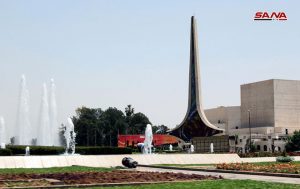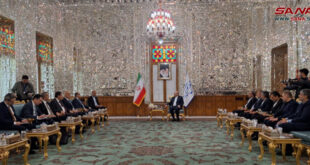Damascus, SANA- The towering Damascene Sword Monument positioned in the middle of the Umayyad Square was associated with the Damascus International Fair as a historical witness and a visual identity rooted in the memory of the Syrians, symbolizing the power and glory of Syria’s civilization.
According to Researcher Imad al-Armashi, the Monument was set up in the early sixties of the twentieth century and coincided with the seventh Damascus International Fair and has been known since it was constructed as a platform for the flags of the countries participating in the Fair where it consists of two fronts facing the courtyard of the Umayyad Square from the west, while the eastern front faces the gate of the Fair’s old place.
Plastic panels were placed inside the Monument, with the flags of the participant countries changing each year according to the participation.
the Monument, with the flags of the participant countries changing each year according to the participation.
The monument was considered a compass for visitors and tourists while the people of Damascus called it the “Fair’s Column” because of its vicinity to the Damascus International Fair.
For years, the Damascene Sword has been featured on numerous publications, posters and special stamps related to the Fair.
On the design and implementation of the monument, al-Armashi explained that the initial design is credited to Eng. Hisham al-Moallem and its construction to Eng. Atef al-Seyoufi under the supervision of Eng. Samy Kaddh, while Dr. Eng. Abdul Mohsen al-Qadmany put the finishing touches to the final design when he was in Egypt in 1960 at the office of Eng. Atef Seyoufi during the unity between Syria and Egypt, while the iron structure inside the sword was constructed by craftsman of Hassan Sa’do.
When the Damascus International Fair was moved to its new headquarter at the Fairground City, the monument lost its main function of carrying flags of the participant countries and the artist Ehsan Entebbe, Dean of the Faculty of Fine Arts, was commissioned to renovate the two sides of the monument designed by artist Abdel-Qader Arnaout, using the stained glass and replacing the idea of the flags with abstract geometric shapes, in a beautiful decorative form that mixes the fire and the rose, making this monument one of the most important and largest stained glass facades in the world.
Manar al-Frieh/Manal
 Syrian Arab News Agency S A N A
Syrian Arab News Agency S A N A

